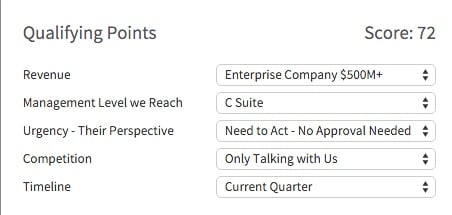- October 24, 2016
- Posted by: Dave Kurlan
- Category: Understanding the Sales Force

What is they key to accurate sales forecasts? Sure, it’s all of the things I’ve written about before, like sales process, uncovering compelling reasons to buy, selling value, thoroughly qualifying, etc. But haven’t you witnessed more than enough opportunities where all of that was completed at an acceptable level and the business still failed to close? Don’t too many of those well qualified opportunities become delayed closes or losses? So what is it? What is the one thing that will accurately predict whether or not an opportunity is strong enough to pursue with everything you’ve got?
It’s the scorecard.
For the past year we have been insistent on including a sales scorecard as one or more steps of the sales process. You might recall that I wrote about scorecards once before, although in that article it was more about how excited I was that Membrain included a scorecard building functionality in its CRM application. This time, I want to emphasize how important it is to build a scorecard and not just any scorecard, but one that is predictive enough to make your forecasts accurate!
So how can you build the perfect scorecard?
It’s a somewhat complicated process where you must follow these steps:
- identify potential criteria that might be predictive
- narrow it down to 5-6 criteria that should be predictive
- for each criteria, create 3-4 conditions
- weight the criteria in order of predictive value
- assign points to each of the conditions
- make sure that if someone meets the ideal condition for each criteria the maximum number of points is equal to 100
- test the scorecard on several opportunities that were won and make sure that the score would have predicted a win.
- test the scorecard on several opportunities that were lost and make sure that the score would have predicted a loss.
- if your first attempt was not predictive, make some changes and retest, finally setting a cut-off score
- install your scorecard as a step in at least two stages of the sales process – expect the score to change over time
With some variations,This example should apply to every company:
Criteria – Level of Decision Maker Reached – Value 15 points
Conditions:
C Suite 15 points
VP 10 points
Manager 5 points
User 0 points
Can you come up with 4-5 more criteria that are always predictive of a sale in your business, with your customers, and against your competition?
Finally, you need to have the discipline to not follow up when a score falls below your cutoff, and to follow up with even more firepower when the score suggests you can win the business. Discipline is more difficult than building the scorecard!
Last chance to register for my presentation of the 6 Hidden Weaknesses That Impact Sales Results on Tuesday, October 25 at 11 AM Eastern. Register here.
